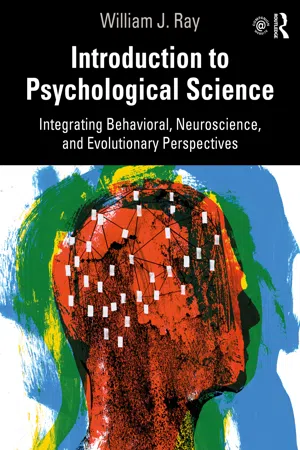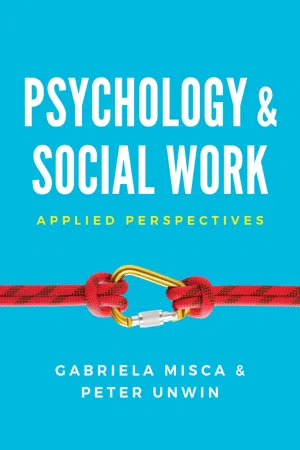Psychology
Psychological Perspectives in the Treatment of Disorders
Psychological perspectives in the treatment of disorders refer to the various theoretical frameworks and approaches used by psychologists to understand and address mental health issues. These perspectives include psychodynamic, behavioral, cognitive, humanistic, and biological perspectives, each offering unique insights into the causes and treatment of psychological disorders. By integrating these perspectives, psychologists can develop comprehensive and personalized treatment plans for individuals with mental health concerns.
Written by Perlego with AI-assistance
Related key terms
1 of 5
7 Key excerpts on "Psychological Perspectives in the Treatment of Disorders"
- eBook - PDF
- Ronald Comer, Elizabeth Gould, Adrian Furnham(Authors)
- 2014(Publication Date)
- Wiley(Publisher)
The knowledge acquired is then used by clinicians, whose role is to detect, assess and treat people with psychological disorders. treatment, or therapy systematic procedures designed to change abnormal behaviour into normal behaviour. psychotherapy a treatment system in which a client and therapist use words and acts to overcome the client’s psychologi- cal difficulties. biological therapy the use of physical and chemical procedures to help people over- come psychological difficulties. Despite Frank ’s straightforward definition, clinical treat- ment is surrounded by conflict and confusion. Carl Rogers frequently expressed the opinion that therapists are not in agreement as to their goals or aims; they are not in agree- ment as to what constitutes a successful outcome of their work; they cannot agree on what constitutes a failure; and that the field seems to be completely chaotic and divided. Some clinicians view disorder as an illness and so con- sider therapy a procedure that helps cure the illness. Others see disorder as a problem in living and therapists as teachers of more functional behaviour and thought. Clinicians even differ on what to call the person who receives therapy. Those who see abnormality as an illness use the label patient, while those who view it as a problem in living refer to the client. This chapter will use both of these common terms inter- changeably. All agree therapy of some kind is necessary and will be effective to differing degrees. Treatment in the Modern Context LEARNING OBJECTIVE 1 Explain who currently receives treatment for psychological problems, how they enter treatment and what general features characterize types of treatment. Surveys suggest that more than 15% of people – children, adolescents and adults – receive therapy for psychological problems in the course of a year (NAMI, 2011). The number and variety of problems for which treatments are available have increased during the past 100 years. - eBook - ePub
Introduction to Psychological Science
Integrating Behavioral, Neuroscience and Evolutionary Perspectives
- William J. Ray(Author)
- 2021(Publication Date)
- Routledge(Publisher)
dialectical behavior therapy, which is an effective treatment of borderline personality disorder.Overall, the existential-humanistic perspective emphasizes the emotional level. There is also an emphasis on the value of internal processes and the manner in which the exploration and experiencing of these internal processes can lead to changes in behavior and experience.Behavioral and Cognitive Behavioral PerspectivesBehavioral therapy focused on changing behaviors through conditioning principles, whereas cognitive behavioral therapy examined the manner in which thoughts influence behaviors. The cognitive behavioral movement seeks to understand how cognitions are disordered or disrupted in mental disorders. Whereas humanistic therapies emphasize emotional processing, cognitive behavioral approaches emphasize thoughts and the manner in which a person thinks about her life and experiences. The basic idea is that psychological disturbances often involve errors in thinking. One real value of many cognitive behavioral approaches is that they have been tested empirically and presented in books and manuals that describe the steps involved in therapy. Cognitive behavioral therapy (CBT) has been developed for a variety of disorders, which will be described later in this chapter.The behavioral perspective, as the name implies, has focused on the level of actions and behaviors. Most histories of behaviorism begin with a discussion of Ivan Pavlov, the Russian physiologist who won the Nobel Prize in 1904 for his work on the physiology of digestion. Pavlov noted in his Nobel Prize speech that the sight of tasty food makes the mouth of a hungry man water. However, what became of interest to behavioral psychologists was not the salivary reflex itself, but the fact that other objects associated with the presentation of food could also produce salivation. For example, in his work with dogs, the sound of the door of the lab being opened preceding the dogs being presented with food would also produce the reflex. In a variety of studies it was shown that any sensory process such as sound that was paired with the food would produce salivation. After a number of pairings, the sound alone without the food could produce this reflex. This came to be known as classical conditioning - eBook - PDF
- David Matsumoto, Linda Juang(Authors)
- 2016(Publication Date)
- Cengage Learning EMEA(Publisher)
310 13 Culture and Treatment for Psychological Disorders CHAPTER CONTENTS Culture and Psychotherapy Traditional Psychotherapy Contemporary Psychotherapy Cultural Limitations of Psychotherapy Psychotherapy in Diverse Cultures Psychotherapy in Diverse Cultures in the United States: An Example of Within Country Variation Summary Receiving Treatment and Barriers to Treatment Disparities in Receiving Treatment Barriers to Seeking Treatment Removing Barriers to Treatment Treatment Issues Culturally Competent Services Indigenous and Traditional Healing An Example of Blending Indigenous Healing Practices with Traditional Western-Based Treatment Approaches A Community Approach to Treatment Culture and Clinical Training CONCLUSION EXPLORATION AND DISCOVERY Why Does This Matter to Me? Suggestions for Further Exploration Copyright 2017 Cengage Learning. All Rights Reserved. May not be copied, scanned, or duplicated, in whole or in part. Due to electronic rights, some third party content may be suppressed from the eBook and/or eChapter(s). Editorial review has deemed that any suppressed content does not materially affect the overall learning experience. Cengage Learning reserves the right to remove additional content at any time if subsequent rights restrictions require it. Culture and Treatment for Psychological Disorders 311 One of the primary goals of psychology is to use the knowledge generated by research to help people improve their lives. In Chapter 12, we discussed the important role that culture plays in defining abnormality. Culture influences how disorders are expressed and our ability to reliably and validly assess and diagnose when abnor-malities have developed into psychopathology. The proper assessment and diagnosis of psychopathology is a necessary step toward helping people with mental disorders improve their lives. In this chapter, we discuss a common approach to addressing psychopathology—namely, psychotherapy. - Lorelle J. Burton, Drew Westen, Robin M. Kowalski(Authors)
- 2022(Publication Date)
- Wiley(Publisher)
INTERIM SUMMARY In group therapy, multiple people meet together to work towards therapeutic goals. A variation on group therapy is self-help groups, which are not guided by a professional. The aim of family therapy is to change maladaptive family interaction patterns. Family therapists often construct a genogram (a map of a family over three or four gener- ations) to pinpoint recurring family patterns over genera- tions. Relationship therapy or couples therapy focuses on the relationship between members of a couple and can rely on psychodynamic, systemic, cognitive or behavioural principles. 19.5 Biological treatments LEARNING OUTCOME 19.5 Discuss the various biological treatments available for patients with severe mental illness. The approaches we have examined thus far all use psychological and interpersonal interventions to address psychological problems. A very different type of treatment emerges from the view that psychological disorders reflect pathology of the brain. Biological treatments use medication to restore the brain to as normal functioning as possible (pharma- cotherapy). If medications are ineffective, clinicians may turn to electroconvulsive (shock) therapy (ECT) or, in extreme cases, psychosurgery. (Unlike psychotherapy, which can be administered by psychologists and other mental health practitioners, biological treatments can be administered only by physicians, most commonly psychiatrists.) The therapeutic action of psychotropic medications, as well as the advantages and disadvantages of using such medications in the treatment of mental health issues, is discussed in the next feature. Psychotropic medications For many years, patients with severe mental illness were sent to state mental hospitals, which provided little more than custodial care in overcrowded wards. But the discovery of psychotropic medications — drugs that act on the brain to affect mental processes (table 19.1) — changed the care of psychiatric patients dramatically.- eBook - PDF
- Douglas Bernstein, , , (Authors)
- 2015(Publication Date)
- Cengage Learning EMEA(Publisher)
Copyright 2016 Cengage Learning. All Rights Reserved. May not be copied, scanned, or duplicated, in whole or in part. Due to electronic rights, some third party content may be suppressed from the eBook and/or eChapter(s). Editorial review has deemed that any suppressed content does not materially affect the overall learning experience. Cengage Learning reserves the right to remove additional content at any time if subsequent rights restrictions require it. 560 Treatment of Psychological Disorders Though the combinations of treatment methods and therapist and client character-istics that are best suited to solving particular psychological problems have not yet been mapped out, a few notable trends have emerged. For example, when differences in the effectiveness of different treatments occur in comparative studies of adult psychotherapy, they tend to reveal a small to moderate advantage for behavioral and cognitive behav-ioral methods—especially in the treatment of phobias and certain other anxiety disorders (e.g., Antony & Barlow, 2010; Chaker, Hofmann, & Hoyer, 2010; Craske & Barlow, 2008; Hollon, Stewart, & Strunk, 2006; Houben, Wiers, & Jansen, 2011; Mochizuki-Kawai et al., 2010; Tolin, 2010), and in the prevention and treatment of eating disorders (Hendricks & Thompson, 2005; Wilson et al., 2010). The same overall trend holds true in the treat-ment of child and adolescent clients (Carr, 2009; Kazak et al., 2010; Kendall et al., 2008). Cognitive methods appear to be less effective, however, at dealing with severe disorders such as schizophrenia (Morrison et al., 2012). Psychodynamic methods are still quite controversial. As shown in Table 15.2, interpersonal therapy and short-term psychody-namic therapy have received strong and modest support, respectively, for the treatment of depression, but some studies have found this approach no more effective overall than placebo or other methods (Shedler, 2010; Smit et al., 2012). - eBook - ePub
Psychology and Social Work
Applied Perspectives
- Gabriela Misca, Peter Unwin(Authors)
- 2017(Publication Date)
- Polity(Publisher)
Another common eating disorder is bulimia nervosa, which involves eating excessive amounts of food (Fairburn and Cooper, 1993). Individuals with bulimia identify with this description, even though the actual caloric intake for binges varies between different individuals (Fairburn et al., 1999). Individuals suffering from bulimia maintain roughly the same weight, making this disorder difficult to identify and so harder for individuals to get the appropriate support and help they require (MIND, 2015b). Depression also commonly occurs in individuals with bulimia (Agras, 2001).Theoretical perspectives in understanding mental illness and treatment approaches
This section of the chapter will explore the key contemporary psychological approaches to the treatment of mental health problems and their supporting evidence. It is important that social workers have an understanding of different types of psychological therapy and their effectiveness if they are to work efficaciously with clients and colleagues. Psychological models have often emerged as alternatives to the medical model, and many such approaches view mental health problems as having an underlying social or psychological cause.From medical model to talking therapies
Psychological therapies – or ‘talking therapies’ (Mental Health Foundation, 2009) – involve a range of interventions aimed at helping people to understand and make changes to their behaviour in order to relieve distress (Callan and Fry, 2012). Talking therapies generally fall into three different categories based on their major theoretical underpinning: psychodynamic therapies, behavioural therapies and humanistic therapies. Stiles et al. (2008) explored a range of different talking therapies within a UK primary care setting and found evidence of their effectiveness, illustrated by 58 per cent of clients having achieved an improvement. Importantly, talking therapies appear to have been steadily increasing in popularity compared to treatment with medication. For example, in a cross-sectional survey of GP surgeries, when patients were asked to rate their preferences regarding treatment for depression, counselling emerged as more popular than drug therapy. This was particularly the case among women, those who believed that antidepressant drugs were addictive and those who had received talking therapies in the past (Churchill et al., 2000).Psychological therapy vs. medication
- eBook - PDF
Journeys Through Mental Illness
Client Experiences and Understandings of Mental Distress
- Juliet Foster(Author)
- 2018(Publication Date)
- Red Globe Press(Publisher)
Perspectives from psychology, psychiatry and other disciplines 16 2 Introduction As highlighted in the previous chapter, a large number of studies in the social sciences have considered the understandings of mental ill health held by various groups. This chapter will review some of these studies, the conclusions we can draw from them and, perhaps more importantly, consider where the gaps lie. One of the most important distinctions that can be made between these studies is that of whose understanding is being considered. Here, I intend to consider three main perspectives: (1) that of the general public (2) that of mental health profes-sionals and (3) that of those who have been defined as ‘mentally ill’, by whatever criteria. It is perhaps symbolic of the bound-aries that exist between these communities that few studies attempt to examine the perspectives of more than one of these groups. It is also significant that, historically, psychology and psychiatry seem to have been less concerned with the views expressed by individuals considered to have mental health problems themselves, creating something of a gap in the litera-ture. This gap is now partially being filled by work in areas out-side mainstream social sciences, especially that undertaken by the mental health service user movements: this will be discussed in the next chapter. Broadly speaking, the main area of interest of this book is the representations of mental health and illness held by those diag-nosed with a mental health problem: however, studies on the beliefs of the public and of mental health professionals also have important implications. What is the relationship between client, professional and public views? Are they as divergent as has been suggested (Round, Bray, Polak & Graham, 1995), or is there a more complex interaction at play? The ideas of the general public might be of particular relevance.
Index pages curate the most relevant extracts from our library of academic textbooks. They’ve been created using an in-house natural language model (NLM), each adding context and meaning to key research topics.






